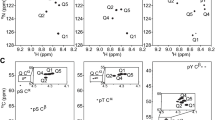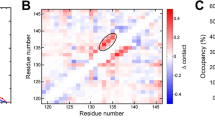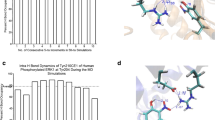Abstract
Each amino acid has its intrinsic propensity for certain local backbone conformations, which can be further modulated by the physicochemical environment and post-translational modifications. In this work, we study the effects of phosphorylation on the intrinsic propensity for different local backbone conformations of serine/threonine by molecular dynamics simulations. We showed that phosphorylation has very different effects on the intrinsic propensity for certain local backbone conformations for the serine and threonine. The phosphorylation of serine increases the propensity of forming polyproline II, whereas that of threonine has the opposite effect. Detailed analysis showed that such different responses to phosphorylation mainly arise from their different perturbations to the backbone hydration and the geometrical constraints by forming side-chain–backbone hydrogen bonds due to phosphorylation. Such an effect of phosphorylation on backbone conformations can be crucial for understanding the molecular mechanism of phosphorylation-regulated protein structures/dynamics and functions.





Similar content being viewed by others

References
Walsh, C.T.: Posttranslational Modification of Proteins: Expanding Nature’s Inventory. Colorado: Roberts and Company Publishers, Englewood (2006)
Marks, F.: Protein Phosphorylation. VCH Verlagsgesellschaft mbH, Weinheim, Germany (1996)
Chen, H.F.: Molecular dynamics simulation of phosphorylated KID post-translational modification. PLoS ONE 4, e6516 (2009)
Jho, Y.S., Zhulina, E.B., Kim, M.W., Pincus, P.A.: Monte Carlo simulations of tau proteins: effect of phosphorylation. Biophys. J 99, 2387–2397 (2010)
Valiev, M., Yang, J., Adams, J.A., Taylor, S.S., Weare, J.H.: Phosphorylation reaction in cAPK protein kinase-free energy quantum mechanical/molecular mechanics simulations. J. Phys. Chem. B 111, 13455–13464 (2007)
Mortishire-Smith, R.J., Pitzenberger, S.M., Burke, C.J., Middaugh, C.R., Garsky, V.M., Johnson, R.G.: Solution structure of the cytoplasmic domain of phospholamban: phosphorylation leads to a local perturbation in secondary structure. Biochemistry 34, 7603–7613 (1995)
Quirk, P.G., Patchell, V.B., Colyer, J., Drago, G.A., Gao, Y.: Conformational effects of serine phosphorylation in phospholamban peptides. Eur. J. Biochem. 236, 85–91 (1996)
Schon, O., Friedler, A., Bycroft, M., Freund, S.M.V., Fersht, A.R.: Molecular mechanism of the interaction between MDM2 and p53. J. Mol. Biol. 323, 491–501 (2002)
Lee, H.J., Srinivasan, D., Coomber, D., Lane, D.P., Verma, C.S.: Modulation of the p53-MDM2 interaction by phosphorylation of Thr18: a computational study. Cell Cycle 6, 2604–2611 (2007)
Fraser, J.A., Vojtesek, B., Hupp, T.R.: A novel p53 phosphorylation site within the MDM2 ubiquitination signal I. Phosphorylation at ser269 in vivo is linked to inactivation of p53 function. J. Biol. Chem. 285, 37762–37772 (2010)
Li, W.F., Wolynes, P.G., Takada, S.: Frustration, specific sequence dependence, and nonlinearity in large-amplitude fluctuations of allosteric proteins. Proc. Natl. Acad. Sci. U.S.A. 108, 3504–3509 (2011)
Li, W.F., Wang, W., Takada, S.: Energy landscape views for interplays among folding, binding, and allostery of calmodulin domains. Proc. Natl. Acad. Sci. U.S.A. 111, 10550–10555 (2014)
Terakawa, T., Takada, S.: Multiscale ensemble modeling of intrinsically disordered proteins: p53 N-terminal domain. Biophys. J. 101, 1450–1458 (2011)
Li, W.F., Zhang, Z., Wang, J., Wang, W.: Metal-coupled folding of Cys2His2 zinc-finger. J. Am. Chem. Soc. 130, 892–900 (2008)
Mao, X.B., Guo, Y.Y., Luo, Y., Niu, L., Liu, L., Ma, X.J., Wang, H.B., Yang, Y.L., Wei, G.H., Wang, C.: Sequence effects on peptide assembly characteristics observed by using scanning tunneling microscopy. J. Am. Chem. Soc. 135, 2181–2187 (2013)
Li, W.F., Zhang, J., Su, Y., Wang, J., Qin, M., Wang, W.: Effects of zinc binding on the conformational distribution of the amyloid-beta peptide based on molecular dynamics simulations. J. Phys. Chem. B 111, 13814–13821 (2007)
Wang, Y., Chu, X.K., Longhi, S., Roche, P., Han, W., Wang, E.K., Wang, J.: Multiscaled exploration of coupled folding and binding of an intrinsically disordered molecular recognition element in measles virus nucleoprotein. Proc. Natl. Acad. Sci. U.S.A. 110, E3743–E3752 (2013)
Jiang, F., Han, W., Wu, Y.D.: The intrinsic conformational features of amino acids from a protein coil library and their applications in force field development. Phys. Chem. Chem. Phys. 15, 3413–3428 (2013)
Jiang, F., Wu, Y.D.: Folding of fourteen small proteins with a residue-specific force field and replica-exchange molecular dynamics. J. Am. Chem. Soc. 136, 9536–9539 (2014)
Kim, S.Y., Jung, Y., Hwang, G.S., Han, H., Cho, M.: Phosphorylation alters backbone conformational preferences of serine and threonine peptides. Proteins 79, 3155–3165 (2011)
Shen, T.Y., Wong, C.F., McCammon, J.A.: Atomistic Brownian dynamics simulation of peptide phosphorylation. J. Am. Chem. Soc. 123, 9107–9111 (2001)
Xiang, S.Q., Gapsys, V., Kim, H.Y., Bessonov, S., Hsiao, H.H., Mohlmann, S., Klaukien, V., Ficner, R., Becker, S., Urlaub, H., Luhrmann, R, De Groot, B., Zweckstetter, M.: Phosphorylation drives a dynamic switch in serine/arginine-rich proteins. Structure 21, 2162–2174 (2003)
Sellis, D., Drosou, V., Vlachakis, D., Voukkalis, N., Giannakouros, T., Vlassi, M.: Phosphorylation of the arginine/serine repeats of lamin B receptor by SRPK1–Insights from molecular dynamics simulations. Biochim. Biophys. Acta 1820, 44–55 (2012)
Vassall, K.A., Bessonov, K., De Avila, M., Polverini, E., Harauz, G.: The effects of threonine phosphorylation on the stability and dynamics of the central molecular switch region of 18.5-kDa myelin basic protein. PLoS ONE 8, e68175 (2013)
Velazquez, H.A., Hamelberg, D.: Dynamical role of phosphorylation on serine/threonine-proline Pin1 substrates from constant force molecular dynamics simulations. J. Chem. Phys. 142, 075102 (2015)
Krimm, S., Tiffany, M.L.: Circular-dichroism spectrum and structure of unordered polypeptides and proteins. Isr. J. Chem. 12, 189–200 (1974)
Shi, Z.S., Olson, C.A., Rose, G.D., Baldwin, R.L., Kallenbach, N.R.: Polyproline II structure in a sequence of seven alanine residues. Proc. Natl. Acad. Sci. U.S.A. 99, 9190–9195 (2002)
Kentsis, A., Mezei, M., Osman, R.: Origin of the sequence-dependent polyproline II structure in unfolded peptides. Proteins 61, 769–776 (2005)
Li, W.F., Qin, M., Tie, Z.X., Wang, W.: Effects of solvents on the intrinsic propensity of peptide backbone conformations. Phys. Rev. E 84, 041933 (2011)
Liu, Z.G., Chen, K., Ng, A., Shi, Z.S., Woody, R.W., Kallenbach, N.R.: Solvent dependence of PII conformation in model alanine peptides. J. Am. Chem. Soc. 126, 15141–15150 (2004)
Lindorff-Larsen, K., Piana, S., Palmo, K., Maragakis, P., Klepeis, J.L., Dror, R.O., Shaw, D.E.: Improved side-chain torsion potentials for Amber99SB protein force field. Proteins 78, 1950–1958 (2010)
Jiang, F., Zhou, C.Y., Wu, Y.D.: Residue-specific force field based on the protein coil library. RSFF1: modification of OPLS-AA/L. J. Phys. Chem. B 118, 6983–6998 (2014)
Hagarman, A., Measey, T.J., Mathieu, D., Schwalbe, H., Schweitzer-Stenner, R.: Intrinsic propensities of amino acid residues in GxG peptides inferred from amide I’ band profiles and NMR scalar coupling constants. J. Am. Chem. Soc. 132, 540–551 (2010)
Shi, Z.S., Chen, K., Liu, Z.G., Ng, A., Bracken, W.C., Kallenbach, N.R.: Polyproline II propensities from GGXGG peptides reveal an anticorrelation with beta-sheet scales. Proc. Natl. Acad. Sci. U.S.A. 102, 17964–17968 (2005)
Plaxco, K.W., Morton, C.J., Grimshaw, S.B., Jones, J.A., Pitkeathly, M., Campbell, I.D., Dobson, C.M.: The effects of guanidine hydrochloride on the ‘random coil’ conformations and NMR chemical shifts of the peptide series GGXGG. J. Biomol. NMR 10, 221–230 (1997)
van der Spoel, D.: The solution conformations of amino acids from molecular dynamics simulations of Gly-X-Gly peptides: comparison with NMR parameters. Biochem. Cell Biol. 76, 164–170 (1998)
He, L., Navarro, A.E., Shi, Z.S., Kallenbach, N.R.: End effects influence short model peptide conformation. J. Am. Chem. Soc. 134, 1571–1576 (2012)
Toal, S., Meral, D., Verbaro, D., Urbanc, B., Schweitzer-Stenner, R.: pH-independence of trialanine and effects of termini blocking in short peptides: a combined vibrational, NMR, UVCD and molecular dynamics study. J. Phys. Chem. B 117, 3689–3706 (2013)
Dean, A.M., Koshland, D.E.: Electrostatic and steric contributions to regulation at the active site of isocitrate dehydrogenase. Science 249, 1044–1046 (1990)
Case, D A, Darden, T.A., Cheatham, III, T.E., Simmerling, C.L., Wang, J., Duke, R.E., Luo, R., Walker, R.C., Zhang, W., Merz, K.M., Roberts, B., Wang, B., Hayik, S., Roitberg, A., Seabra, G., Kolossvry, I., Wong, K.F., Paesani, F., Vanicek, J., Liu, J., Wu, X., Brozell, S.R., Steinbrecher, T., Gohlke, H., Cai, Q., Ye, X., Wang, J., Hsieh, M.-J., Cui, G., Roe, D.R., Mathews, D.H., Seetin, M.G., Sagui, C., Babin, V., Luchko, T., Gusarov, S., Kovalenko, A., Kollman, P.A.: AMBER 11. University of California, San Francisco (2010)
Duan, Y., Wu, C., Chowdhury, S., Lee, M.C., Xiong, G.M., Zhang, W., Yang, R., Cieplak, P., Luo, R., Lee, T., Caldwell, J., Wang, J.M., Kollman, P.: A point-charge force field for molecular mechanics simulations of proteins based on condensed-phase quantum mechanical calculations. J. Comput. Chem. 24, 1999–2012 (2003)
Craft, J.W., Legge, G.B.: An AMBER/DYANA/MOLMOL phosphorylated amino acid library set and incorporation into NMR structure calculations. J. Biomol. NMR 33, 15–24 (2005)
Best, R.B., Zhu, X., Shim, J., Lopes, P.E.M., Mittal, J., Feig, M., MacKerell, A.D.: Optimization of the additive CHARMM all-atom protein force field targeting improved sampling of the backbone φ, ψ and side-chain χ(1) and χ(2) dihedral angles. J. Chem. Theory. Comput. 8, 3257–3273 (2012)
MacKerell, A.D., Feig, M., Brooks, C.L.: Extending the treatment of backbone energetics in protein force fields: limitations of gas-phase quantum mechanics in reproducing protein conformational distributions in molecular dynamics simulations. J. Comput. Chem. 25, 1400–1415 (2004)
MacKerell, A.D., Bashford, D., Bellott, M., Dunbrack, R.L., Evanseck, J.D., Field, M.J., Fischer, S., Gao, J., Guo, H., Ha, S.: All-atom empirical potential for molecular modeling and dynamics studies of proteins. J. Phys. Chem. B 102, 3586–3616 (1998)
Berendsen, H. J. C., Van der Spoel, D., Van Drunen, R.: GROMACS: A message-passing parallel molecular dynamics implementation. Comp. Phys. Comm. 91, 43–56 (1995)
Van der Spoel, D., Lindahl, E., Hess, B., Groenhof, G., Mark, A.E., Berendsen, H.J.C.: GROMACS: Fast, Flexible and Free. J. Comp. Chem. 26, 1701–1718 (2005)
Hess, B., Kutzner, C., van der Spoel, D., Lindahl, E.: GROMACS 4: Algorithms for highly efficient, load-balanced, and scalable molecular simulation. J. Chem. Theory. Comput. 4, 435–447 (2008)
Jorgensen, W.L., Chandrasekhar, J., Madura, J.D., Impey, R.W., Klein, M.L.: Comparison of simple potential functions for simulating liquid water. J. Chem. Phys. 79, 926–935 (1983)
Van Gunsteren, W.F., Berendsen, H.J.C.: Algorithms for macromolecular dynamics and constraint dynamics. Mol. Phys. 34, 1311–1327 (1977)
Darden, T., York, D., Pedersen, L.: Particle mesh Ewald: an N ∗log(N) method for Ewald sums in large systems. J. Chem. Phys. 98, 10089–10092 (1993)
Sugita, Y., Okamoto, Y.: Replica-exchange molecular dynamics method for protein folding. Chem. Phys. Lett. 314, 141–151 (1999)
Walter, N., Hansmann, U.H.E.: Dynamics and optimal number of replicas in parallel tempering simulations. Phys. Rev. E 76, 065701 (2007)
Garcia, A.E.: Characterization of non-alpha helical conformations in Ala peptides. Polymer 45, 669–676 (2004)
Avbelj, F., Luo, P.Z., Baldwin, R.L.: Energetics of the interaction between water and the helical peptide group and its role in determining helix propensities. Proc. Natl. Acad. Sci. U.S.A. 97, 10786–10791 (2000)
Avbelj, F., Baldwin, R.L.: Origin of the neighboring residue effect on peptide backbone conformation. Proc. Natl. Acad. Sci. U.S.A. 101, 10967–10972 (2000)
Poon, C.D., Samulski, E.T., Weise, C.F., Weisshaar, J.C.: Do bridging water molecules dictate the structure of a model dipeptide in aqueous solution. J. Am. Chem. Soc. 122, 5642–5643 (2000)
Creamer, T.P., Campbell, M.N.: Determinants of the polyproline II helix from modeling studies. Adv. Protein Chem. 62, 263–282 (2002)
Acknowledgments
This work was supported by the National Natural Science Foundation of China (Grant numbers 11574132, 11174133, 11174134, and 11274157) and Jiangsu Province (BK2011546). W.L. also acknowledges the support of the Program for New Century Excellent Talents in University and the PAPD project of Jiangsu higher education institutions. The numerical calculations in this paper have been done on the IBM Blade cluster system in the High Performance Computing Center of Nanjing University.
Author information
Authors and Affiliations
Corresponding authors
Electronic supplementary material
Below is the link to the electronic supplementary material.
Rights and permissions
About this article
Cite this article
He, E., Yan, G., Zhang, J. et al. Effects of phosphorylation on the intrinsic propensity of backbone conformations of serine/threonine. J Biol Phys 42, 247–258 (2016). https://doi.org/10.1007/s10867-015-9405-0
Received:
Accepted:
Published:
Issue Date:
DOI: https://doi.org/10.1007/s10867-015-9405-0



